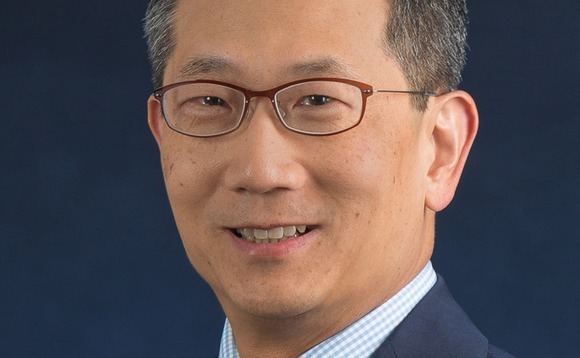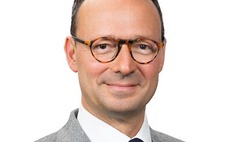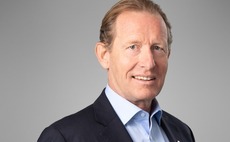
Q&A: The Carlyle Group's Kewsong Lee

Kewsong Lee, CEO of The Carlyle Group, discusses the firm’s response to COVID-19, finding alpha in a low growth world, not allowing size to inhibit speed of action, and embracing work-from-home
Q: How did Carlyle's global presence – and ability to see COVID-19 roll out across different markets at different times – inform the response to the pandemic?
A: The number one priority is the health and safety of our people. Seeing this crisis develop in one part of the world and roll through other parts of the world, we could look at what folks were doing, what best practices might be, and quickly try and bring that to our other offices. The global platform was also incredibly helpful in thinking about what to do now – figuring out the impact of the crisis on different industries and companies and where the opportunities are. With respect to that, what we first did was to make sure our existing assets were well taken care of. The best way to make money is first not lose it. The entire organization got together and shared observations to make sure the portfolio was in good shape and to transfer knowledge to portfolio company CEOs and management teams. Once that work was underway, we asked where the opportunities would emerge based on what we are seeing in the US, Asia, Europe, and Latin America. It is enormously helpful having a global platform if you have a culture and a team with an ability to share, where folks are willing to offer points of view, and where people are connected.
Q: How do you plan for the uncertainties of a post-COVID-19 world?
A: We must prepare for the long haul and the long grind, and preparing an organization is about psychological and physical stamina. Everyone thinks the crisis is here and going to be over. No. The environment has changed. By infusing all that liquidity into the system, central banks and policymakers have made our jobs harder. It has enabled lots of companies to bridge to the future while trying to work their way through this complicated environment. In the last great financial crisis, clearly there was dislocation and clearly financial markets had real issues. Back then, you would look at companies and say these are solvent companies but illiquid. Today the situation has almost flipped on its head. You may have a lot of insolvent companies that are liquid because of the availability of liquidity. As a result, distress isn't as big an opportunity as we had expected. Eventually that runway runs out or these companies figure out a way to grow or change their business models so they can survive. But at some point, I would expect the real economy to catch up because liquidity is not the same as solvency.
Q: So where do you find alpha in a low growth, low yield world?
A: The good news is the private markets have afforded relative outperformance over the years and so it's an asset class that continues to be in demand – if anything in more demand in light of the fact that rates could be low forever. There are three ways to drive returns on equity: buy low and sell high, hoping that multiples expand; use financial leverage; or grow earnings and cash flow. At Carlyle, we do not bet on multiple expansion. It is very difficult to assume that in this high asset price and high valuation world, you could see multiples going even higher. It is also hard to imagine that you can get even more leverage, more gearing, or even a lower cost of capital than what we see today. Even if you could, we are talking basis points, so it's not going to move the needle as much as it might have done when rates were 10%. This means you've got to do business the old-fashioned way: grow the top line, improve capital efficiency, drive margins, and help companies grow. It's all about having deep sector expertise and strong corporate resources that can help with procurement, digital technology, human capital assessment, capital markets, and financing transactions. That sector expertise also means we can find great management teams and interesting companies.
Q: And this happens irrespective of geography?
A: We are all over the world, but if you had to tilt a bit, we are hugely committed and very bullish on all parts of Asia. If you have an orientation to seek growth, it leads you to Asia, it leads you to technology and healthcare, and it leads you to growth theses with respect to private equity. For a lot of different reasons, when you throw all those things together, Asia is a place where we will be active. This year we have been very vibrant in Asia. It's the first part of our franchise that saw an uptick in terms of activity. Through nine months, we have committed $1.5 billion or more in everywhere from China to India to Korea across healthcare, technology, financial services, and consumer.
Q: What are the implications of gravitation – among private investors generally – to healthcare and technology?
A: High prices. This is where you need real industry expertise, you need to be able to understand the CEO and the partner, and you need to have real insight into the business models and their ability to grow in the long term. You are certainly not getting a bargain when you buy these companies, so you better know your stuff. You must justify the prices you are paying with real high growth and if that doesn't materialize you lose on two fronts. If the business plan doesn't achieve what it was supposed to, the multiple is probably going to shrink because you paid up assuming growth would accelerate. Not only that, but the lower multiple will also be applied on worse results, so you get a double whammy in terms of investment. That's why growth investing is hard.
Q: What trends are you seeing in terms of LP demand for alternatives exposure?
A: First, they want to stay fully committed and deploy into private markets and private equity is the largest part of that. We are not seeing any change whatsoever; if anything, there is a desire for slightly more allocation. Second, they are trying to do more with fewer GPs. This is going to benefit the larger platforms, the more established players, the strong brands with a sense of institutional permanence that LPs can count on in the decades to come. Third, LPs are very understanding of the fact that yields are zero. They are trying to rotate out of traditional fixed income where they are earning nothing and trying to figure out how to capture more premium. We are seeing growth in private credit with different strategies that take advantage of volatility or that manage risk and yield, such as infrastructure credit, and we are seeing continued interest in private equity.
Q: To what extent will the future involve institutional investors making multi-billion-dollar strategic commitments that cut across asset classes?
A: I wish it were as simple as that. Once an LP identifies an optimal portfolio, the GPs they like and the strategies they want to deploy into, we have a series of conversations as to what we see coming to market and how that fits up with what they are trying to do. It's more of a partnership approach and it means fundraising is not episodic, but more of a continuing dialogue where we help solve problems for them.
Q: Does that mean allocations could be thematic rather than tied to specific asset classes?
A: It depends on the style, culture, and internal politics of the LP. Some are very top-down driven, others really rely on individual teams by asset class or by country, or even within country where they decentralize it and local teams make decisions based on allocations from above. Then there is a strategic overlay where they are pushing for co-investment or looking for new or uncorrelated strategies. Every LP is a bit different.
Q: How significant will Fortitude, the insurance business acquired from AIG, become to Carlyle's fundraising?
A: It's a very important strategic pool of capital for Carlyle. We are not an insurance company; I don't want to be in the insurance business. We are the preferred investment management partner for Fortitude, and as its assets grow, it will allocate more to Carlyle. It is a semi-permanent pool of capital that deploys into Carlyle with respect to alternatives. From the perspective of Fortitude, if you think low interest rates and zero yields are difficult for pensioners, imagine how it is for insurance companies with long-dated liabilities. They are trying to figure out how to invest and they can't find any yield. They are struggling with respect to what to do with their investment portfolios, and the ability of firms like Carlyle to help them will be an increasing trend in the future.
Q: How do you remain nimble and innovative even as the emphasis on fee-earning assets means you seek scale and operating leverage within the major platforms?
A: Our platform, across regions and industry teams, is always seeing interesting entrepreneurs and business plans. As you grow, the way you preserve and maintain an entrepreneurial spirit is by maintaining a good balance between local capability sets and centralized planning and leadership. You don't want everything so controlled by DC or New York that there is no ability to be nimble and seek out new ideas; you want energy from the grassroots because that's where interesting things start to happen. I feel good about the way Carlyle is constructed because we have that blend of local versus central partnership. A lot of other firms in our business tend to be a lot more monolithically driven or they are so grassroots there is no sense of platform, corporate resources or sharing or help. You want to be somewhere in between.
Q: When you have a free flow of ideas from different teams and strategies, does it complicate how opportunities are allocated to different pools of capital?
A: That's a happy problem. If there is too much conflict it means you haven't defined territories and mandates well enough. If there is zero conflict, it probably means there is a lot of white space your teams aren't addressing. So far, we haven't had big issues with three or four teams overlapping. If anything, we get two or three regions coming together to do global deals. We just carved out a drive systems business from Siemens, which was a great collaboration between our Asia team and our Europe team. When we did Golden Goose, the footwear company, Europe, America, and China came together to help out.
Q: How have things like work-from-home changed your views on how a private equity firm should operate long term?
A: You call it working from home, I call it living at work. I notice two different mindsets that exist with executives. One group says, "Let's hang on and figure out how to get back to the office," so there is some notion of a return to normal, although maybe not exactly what it was a year ago. Another group says, "We have to coexist and adapt." I am in the camp of there is no going back, there is just before and after. It's going to be different and the faster we embrace that and adapt, push, innovate and continue going, the better off we are going to be. At the same time, technology is going to unleash massive productivity and unbelievable effectiveness and efficiency. In nine months, we have raised $18 billion versus $16 billion last year, and that's without meeting LPs in person. It has been all virtual. We are having global meetings, connecting people to work together who have never been able to do that before. I am very cognizant of the fact that there could be cultural and social issues and I'm very aware this is a mentorship business. What does that mean in terms of onboarding new employees we've never met before? How do you develop the social nuances to enable creative interaction that normally occurs in the hallways? A lot of leaders are focused on how they can manage these issues in this type of environment.
Q: You became co-CEO of Carlyle in 2018 and now you hold the position on your own. How have you managed this internally and externally?
A: I'm proud of all the work that we have done and excited by what lies ahead. We needed to ensure a smooth transition, and to a large extent, we haven't really missed a beat. We have a strong sense of strategic objective and purpose and have worked hard to ensure we have real prioritization, clarity of objectives, clarity of accountability, and clarity of decision making. We have a great team focused on getting the right people in the room to make some decisions and go.
Latest News
Asian GPs slow implementation of ESG policies - survey
Asia-based private equity firms are assigning more dedicated resources to environment, social, and governance (ESG) programmes, but policy changes have slowed in the past 12 months, in part due to concerns raised internally and by LPs, according to a...
Singapore fintech start-up LXA gets $10m seed round
New Enterprise Associates (NEA) has led a USD 10m seed round for Singapore’s LXA, a financial technology start-up launched by a former Asia senior executive at The Blackstone Group.
India's InCred announces $60m round, claims unicorn status
Indian non-bank lender InCred Financial Services said it has received INR 5bn (USD 60m) at a valuation of at least USD 1bn from unnamed investors including “a global private equity fund.”
Insight leads $50m round for Australia's Roller
Insight Partners has led a USD 50m round for Australia’s Roller, a venue management software provider specializing in family fun parks.







